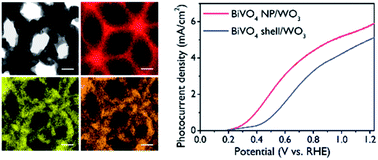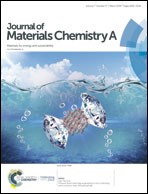Growth of BiVO4 nanoparticles on a WO3 porous scaffold: improved water-splitting by high band-edge light harvesting†
Abstract
The BiVO4/WO3 heterojunction is the ideal photoanode for highly efficient solar water splitting. Despite much effort, the low light absorption efficiency near the BiVO4 band gap wavelength is still a major cause of loss of water-splitting efficiency. To address this issue, we introduce a BiVO4/WO3 photoanode in which BiVO4 single crystal nanoparticles (NPs) are decorated. In particular, we present a limited growth method in confined geometry to synthesize BiVO4 NPs. These BiVO4 NPs enhance Rayleigh-type light scattering, especially at the absorption edge wavelengths, resulting in increased light absorption efficiency (ηabs) at the corresponding wavelengths; the BiVO4 NPs dramatically improved the ηabs up to 60% at 500 nm, which is more than twice as high as the ηabs values obtained for previously reported BiVO4 photoanodes. In addition, BiVO4 NPs exhibit high charge separation efficiency, especially at low bias potentials. This result indicates effective charge transport in the NP morphology. As a result, the BiVO4 NP-coated WO3 photoanode achieves a remarkably high water splitting photocurrent of 5.8 ± 0.18 mA cm−2. This is the highest water-splitting photocurrent among those previously reported for BiVO4-based photoanodes.



 Please wait while we load your content...
Please wait while we load your content...